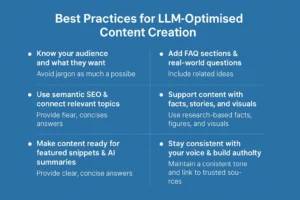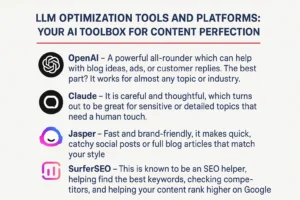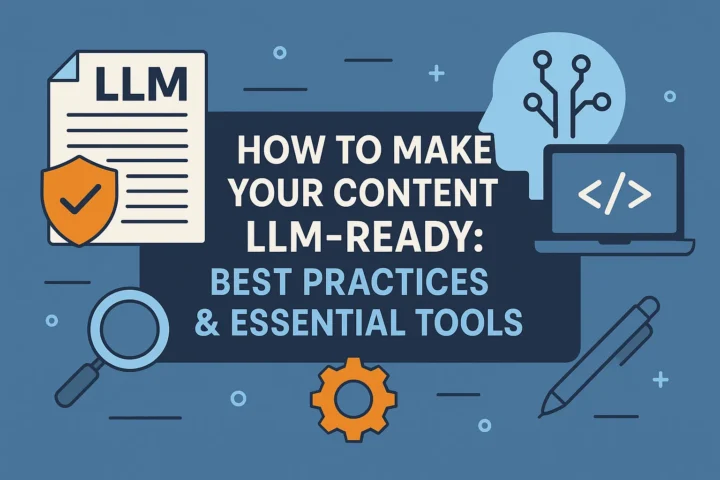Ever come across the term “LLM’’? If not, this stands for Large Language Models, which is the AI algorithm that helps power your widely used models like ChatGPT, Gemini, and so on. Imagine you need to craft content fast but are unable to come up with anything! Here is where LLM (Large Language Model) Optimisation steps up to help create and structure your content in a much better way. This especially comes in handy when optimising website content or even for content marketing optimisation purposes. To understand exactly how you can utilise the best practice for LLM, have a look at the guide below.
Why It’s Important to Align Your Content with LLMs
If you are wondering why you need to give so much thought to making your content LLM-Optimised, then there are many benefits to doing so. In today’s fast-paced world, people require not just clear and useful content but also content that is quick, which is where LLMs step in to make it easier to create this type of content. It is not here to replace humans but to help deliver content that is faster and more effective on a larger scale.
There are many reasons why incorporating LLMs for content strategy holds importance, including:
- It’s easier for AI to understand your message if you use good formatting, SEO, and a clear voice.
- It provides fast content on a large scale, be it 10 or 1,000 pieces, without a dip in quality.
- Helps craft useful messages which fit the wants and actions of each person.
- Easy to find on search engines because LLMs know how search engines work, which makes information easier to find.
- Helps target the right people by making sure that the tone, style, and amount of detail are right for each group.
Developing an AI-Friendly Content Approach
Whether for website content optimisation or optimisation for content marketing, you need to come up with a clear plan before using LLM to help optimise your content:
- Review What You Already Have: Check various types of content, such as blogs, product descriptions or webpages that are already written, and understand which parts are outdated, or the tone and quality need updating for AI to step in and help out.
- Check Parts Which Can be Automated: To relieve some stress on the human team, make sure to review which sections do not need a person to help write from scratch, which includes FAQs, social media captions, snippets for emails and so on.
- Keep Your Prompts Simple But Clear: While LLMs are here to help ease your workload, they do need clear instructions that can help them understand better, which is why you need to include prompt guidelines that are set according to the tone and style of your brand, while telling it the things it needs to avoid.
- Feedback Goes a Long Way: With LLM, the more feedback it gets, the more space it has to improve and grow, which is why you need to keep the loop going and check it for feedback to adjust your prompts accordingly, and not just use it once and move ahead.
Best Practices for LLM-Optimised Content Creation

Make your content LLM-optimised with the help of these useful tips:
- Know Your Audience and What They Want
LLMs are generally tailored to understand user intent, which is why it is crucial to know the audience you are catering to and what they are most likely to search. Some users may want detailed guides, while others may just be looking for quick lists to read. Based on this information, you can tailor your content to match this intent from the very beginning.
- Write Clear, Organised, and Short Content
Avoid jargon as much as possible, because clarity goes a long way with LLM models. Your optimised content should include short and direct sentences or paragraphs, bullet points, and a well-designed structure that is easy to read – keeping it neat and organised for your audience!
- Use Semantic SEO & Connect Relevant Topics
Instead of isolated keywords or stuffing the same keyword multiple times, be sure to include related words and ideas that can help explain your topic in a better manner. Another useful tip is to mention well-known brands or places in your content because this can increase the relevance and context of your writing, causing it to appear in more related searches.
- Add FAQ Sections & Real-World Questions
Many people who read content online, and LLMs, prefer to read content that is simple and easy to grasp, just like how they speak on a daily basis. Which is why it becomes crucial to add Frequently Asked Questions (FAQs) at the end of your content, to make it sound more relatable to people and, at the same time, increase the relevance of your content by showing up in voice search and AI answers.
- Make Content Ready for Featured Snippets & AI Summaries
A clear, concise answer goes a long way in getting featured by a Google snippet or AI summary. Make sure to keep your response within 40 to 60 words right after a question to increase your chances of appearing on any one of these mentioned above.
- Support Content with Facts, Stories, and Visuals
Believe it or not, research-based facts and figures, or even expert quotes, can immediately enhance credibility and quickly capture attention from readers. To make your content even more interesting, include visual cues like charts, graphs and tables to hold attention spans and help people stay on your page longer.
- Stay Consistent with Your Voice & Build Authority
Be sure to understand the tone of the brand you are writing for, and maintain consistency while always adding links to trusted sources to help back your points. Refrain from using uncertain language or “guesswork” until really necessary.
LLM Optimisation Tools and Platforms: Your AI Toolbox for Content Perfection

Have a look at the different types of LLM-powered tools that help make your tasks considerably easier at any time of the day:
- OpenAI – A powerful all-rounder which can help with blog ideas, ads, or customer replies. The best part? It works for almost any topic or industry.
- Claude – It is careful and thoughtful, which turns out to be great for sensitive or detailed topics that need a human touch.
- Jasper – Fast and brand-friendly, it makes quick, catchy social posts or full blog articles that match your style.
- SurferSEO – This is known to be an SEO helper, helping find the best keywords, checking competitors, and helping your content rank higher on Google.
Conclusion
In the fast-paced digital world of today, you need to make sure your information is LLM-ready. This makes your website content and content marketing work better by making them clearer, more relevant, and simpler for AI to understand. Best practices for LLMs say that you should know your audience, use simple language, use semantic SEO, add frequently asked questions, and try for featured snippets. In all, website content improvement is faster and better when you use tools like OpenAI, Claude, Jasper, and SurferSEO. Not only will the results help you get higher rankings, but they will also bring you more visitors and help you connect with your audience better.
Frequently Asked Questions (FAQs)
Q1. How do LLMs shape content strategies?
By allowing you to write relevant, clear content that is focused on user intent, LLMs can help optimise your content in such a way that it performs better in AI-powered search results and voice assistants. This is done by encouraging you to write in structured and concise language to help increase both the relevance and reach of your content.
Q2. What are key tips for making content work with LLMs?
The best practice for LLMs to align with content strategy includes knowing your audience, keeping it simple, using related keywords and ideas, including FAQs, aiming for snippets or summaries in AI, adding facts and visuals, and staying consistent in tone to maintain authority.
Q3. Which tools can help optimise content for LLMs?
There are multiple tools that can help optimise content for LLMs. Some of these include models like OpenAI, Jasper, Claude, Gemini, SurferSEO and so on.
Q4. What pitfalls to avoid with LLM content strategies?
When aligning your content to match with LLM integration, make sure not to write unclear text, skip out on FAQs, stuff keywords together, or publish any content without checking credible sources.

